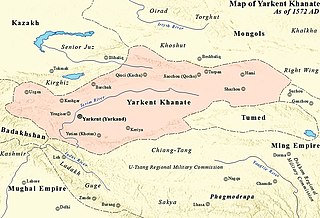Related Research Articles

The Chagatai Khanate, or Chagatai Ulus was a Mongol and later Turkicized khanate that comprised the lands ruled by Chagatai Khan, second son of Genghis Khan, and his descendants and successors. At its height in the late 13th century the khanate extended from the Amu Darya south of the Aral Sea to the Altai Mountains in the border of modern-day Mongolia and China, roughly corresponding to the area once ruled by the Qara Khitai.
Tughlugh Timur Khan (1312/13–1363) was the Khan of Moghulistan from c. 1347 and Khan of the whole Chagatai Khanate from c. 1360 until his death. Esen Buqa is believed to be his father. His reign is known for his conversion to Islam and his invasions of Transoxiana.
Buyan Suldus was chief of one segment of the Suldus clan of Taichuud tribe during the 1350s and 1360s, and was chief amir of the Chagatai ulus for a short time after 1358.

Esen Buqa II was Khan of Moghulistan from 1429 until his death. He was the younger son of Uwais Khan.

Yunus Khan, was Khan of Moghulistan from 1462 until his death in 1487. He is identified by many historians with Ḥājjī `Ali, of the contemporary Chinese records. He was the maternal grandfather of Babur, founder of the Mughal Empire.

Moghulistan, also called the Moghul Khanate or the Eastern Chagatai Khanate, was a Mongol breakaway khanate of the Chagatai Khanate and a historical geographic area north of the Tengri Tagh mountain range, on the border of Central Asia and East Asia. That area today includes parts of Kazakhstan, Kyrgyzstan, and northwest Xinjiang, China. The khanate nominally ruled over the area from the mid-14th century until the late 17th century.
Sultan Said Khan ruled the Yarkent Khanate from September 1514 to July 1533. He was born in the late 15th century in Moghulistan, and he was a direct descendant of the first Moghul Khan, Tughlugh Timur, who had founded the state of Moghulistan in 1348 and ruled until 1363. The Moghuls were turkicized Mongols who had converted to Islam.
Mansur Khan (1482/3–1543), was the last khan of a united Moghulistan from 1503 until his death. From his father Ahmad Alaq, the previous khan, he inherited the eastern parts of Moghulistan proper, the Muslim oasis cities of Yanqi, Bay, and Kuqa, and the Buddhist "Uighur" holdout of Turfan. He also led a jihad of conquest against Oirat Mongol and Chinese territories to the east, including Hami and Dunhuang, and attempted to convert the Kyrgyz to Islam.

Mirza Muhammad Haidar Dughlat Beg was a Chagatai Turco-Mongol military general, governor of Kashmir, and a historical writer, He was a Mughal Dughlat prince who wrote in Persian. Haidar and Babur were cousins on their mother's side, through the line of Genghis Khan. Unlike Babur, Haidar considered himself more of an ethnic Mongol of Moghulistan.
The Dughlat clan was a Mongol clan that served the Chagatai khans as hereditary vassal rulers of several cities in western Tarim Basin, in modern Xinjiang, from the 14th century until the 16th century. The most famous member of the clan, Mirza Muhammad Haidar, was a military adventurer, historian, and the ruler of Kashmir (1541–1551). His historical work, the Tarikh-i Rashidi, provides much of the information known about the family.
The Qara'unas or Negüderi were a Mongol people who settled in Afghanistan after moving from Turkestan and Mongolia.

The battle of Balkh was a key success in Timur's rise to power, and established him as the ruler of the western Chagatai Khanate in Transoxiana.

Qamar-ud-din Khan Dughlat was a Mongol ruler of Moghulistan between 1368 and 1392. He belonged to the Dughlat clan of Mongol warlords.
Khizr Khwaja Khan was the son of Tughlugh Timur and Khan of Moghulistan during the Chagatai Khanate, reigning from 1390 to 1399 AD.
Muhammad Khan was a son of Khizr Khoja and was Khan of Moghulistan from 1408 to 1415.

The Yarkent Khanate, also known as the Yarkand Khanate and the Kashghar Khanate, was a Sunni Muslim Turkic state ruled by the Mongol descendants of Chagatai Khan. It was founded by Sultan Said Khan in 1514 as a western offshoot of Moghulistan, itself an eastern offshoot of the Chagatai Khanate. It was eventually conquered by the Dzungar Khanate in 1705.

Timurid conquests and invasions started in the seventh decade of the 14th century with Timur's control over Chagatai Khanate and ended at the start of the 15th century with the death of Timur. Due to the sheer scale of Timur's wars, and the fact that he was generally undefeated in battle, he has been regarded as one of the most successful military commanders of all time. These wars resulted in the supremacy of Timur over Central Asia, Persia, the Caucasus and the Levant, and parts of South Asia and Eastern Europe, and also the formation of the short-lived Timurid Empire. Scholars estimate that his military campaigns caused the deaths of 17 million people, amounting to about 5% of the world population at the time.
Battle of Belh was a successful battle of the Chagatai Khanate against Timur.
Khoja is a surname. Notable people with the surname include:
Anka Tore, also Enge Tore, was an Emir of a large Ulus in Moghulistan. He is mentioned in the works of Zafarnama Yazdi, Zafarnama Shami and Mojmal al-Tawarikh. He fought against Timur for dominance in the region.
References
- ↑ Kia, M. (2017). The Ottoman Empire: A Historical Encyclopedia [2 Volumes]. United States: ABC-CLIO.
- ↑ The History of Kazakhstan from the Earliest Period to the Present Time. Volume I. (2022). Russia: ЛитРес.
- ↑ The History of Kazakhstan from the Earliest Period to the Present Time. Volume I. (2022). Russia: ЛитРес.
